#AHA BLS and ASHI BLS
Explore tagged Tumblr posts
Text
Basic Life Support in Lahore on Apr 28
Basic Life Support (BLS) program is for participants to gain or improve knowledge and skill proficiency in high-quality CPR skills. In our hands-on approach, students participate in scenarios and learning stations to become a Lifesaver! BLS reflects the latest resuscitation science and treatment recommendations published and conforms with the American Heart Association (AHA) Guidelines Update for…

View On WordPress
#Adult BLS#AHA#AHA BLS#AHA BLS and ASHI BLS#AHA BLS certification#American BLS Certification#American heart association#american safety and health institute#ashi#ASHI Basic Life Support#ASHI BLS#ASHI BLS Certification#ASHI BLS Course#ASHI BLS training#ASHI USA BLS#basic life support#Basic Life Support by American Safety and Health Institute#Basic Life Support by ASHI#Basic Life Support Certification#BLS certification#BLS certification course in Karachi#BLS certification in Karachi#BLS certification in Lahore#BLS Course#BLS course in Karachi#BLS course in Lahore#BLS for allied healthcare professionals#BLS for care providers#BLS for doctors#BLS for healthcare professionals
0 notes
Text
CPR Certification - Which CPR Class Should I Take?

CPR Certification. It's time to take a CPR and First Aid class so you start to search the web. Tons of choices show up: CPR, BLS, AED, CPR for the Professional Rescuer, etc . Which one do you need? Let's go over each individually: CPR and AED CPR and AED is the most basic cpr classes available. This will cover Adult, Child, together with Infant CPR, the AED (Automated External Defibrillator), and conscious and unconscious choking. This class is designed for parents, teachers, personal trainers, security guards, babysitters, etc . It is important to make sure that you get a 2 year CPR certification card account with this course. Make sure that it is either taught through the American Heart Association (AHA) or the American Protection and Health Institute (ASHI). BLS (Basic Life Support for the Healthcare Provider) BLS for the Healthcare Provider CPR is an American Heart Association course covering all of the above, along with 2 person CPR, AED, and the bag-valve-mask. It is the required course for medical personnel, firefighters, paramedics, doctors, dentists, and nurses. If you are going to end up working in a hospital, make sure that you take this course. Many hospitals will only accept certification through the AHA. CPR for any Professional Rescuer CPR for the Professional Rescuer is similar to the BLS course, but it is taught through the North american Red Cross. It is also a 2 year certification, however it is not accepted as readily as the BLS category. If you have the choice, I would not recommend Red Cross CPR Classes! Corporate / Group Training Do you need Set CPR Training? Some CPR training companies will come to your business and train your employees onsite! Confident ask! Still not sure which class you need? Let us help you! Ask us below!
0 notes
Text
CPR Certification - Which CPR Class Should I Take?
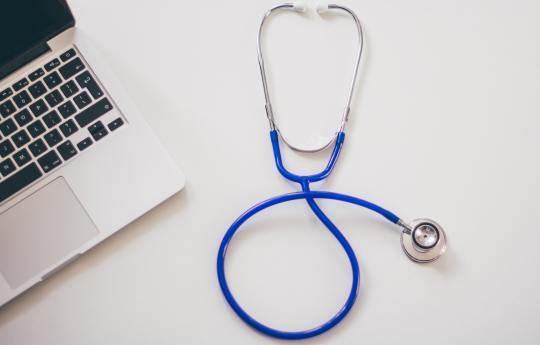
CPR Certification. It's time to take a CPR and First Aid class so you start to search the web. Tons of choices come up: CPR, BLS, AED, CPR for the Professional Rescuer, etc . Which one do you need? Let's go over each individually: CPR and AED CPR and AED is the most basic CPR class available. This will cover Adult, Child, and Infant CPR, the actual AED (Automated External Defibrillator), and conscious and unconscious choking. This class is perfect for parents, teachers, personal trainers, guards, babysitters, etc . It is important to make sure that you get a 2 year CPR certification card with this course. Make sure that it is either coached through the American Heart Association (AHA) or the American Safety and Health Institute (ASHI). BLS (Basic Life Assistance for the Healthcare Provider) BLS for the Healthcare Provider CPR is an American Heart Association course covering all of the above, together with 2 person CPR, AED, and the bag-valve-mask. It is the required course for medical personnel, firefighters, paramedics, doctors, dental practitioners, and nurses. If you are going to be working in a hospital, make sure that you take this course. Many hospitals will only accept certification with the AHA. CPR for the Professional Rescuer CPR for the Professional Rescuer is similar to the BLS course, but it is educated through the American Red Cross. It is also a 2 year certification, however it is not accepted as readily as the orange county cpr classes. If you have the choice, I would not recommend Red Cross CPR Classes! Corporate / Group Training Do you need Team CPR Training? Some CPR training companies will come to your business and train your employees onsite! Don't forget to request! Still not sure which class you need? Let us help you! Ask us below! Zack Zarrilli is a Firefighter and the proprietor of SureFire CPR. His company is comprised of Firefighters, Paramedics, Lifeguards, and EMTs who teach hundreds of CPR, AED, and First Aid classes every year. SureFire CPR's instructors teach from their own real world experience and specialize in on-site CPR and First Aid training in all of Southern California.
0 notes
Text
MEDICAL INSTRUCTOR - BLS/ACLS/PALS
MEDICAL INSTRUCTOR – BLS/ACLS/PALS
[ad_1] The Role We are currently hiring either a full time or part-time BLS/ACLS/PALS trainer who is already approved through DCAS and has approval from American Safety and Health Institute or AHA Registered Nurse (UAE Licensed) with at least two years of experience ASHI – AHA – DCAS Approved BLS/ACLS/PALS Certified Instruc… [ad_2] Source link
View On WordPress
0 notes
Text
Don’t Take Any/ Another CPR Training Class Before Reading This
Identifying that CPR training is a very important life-saving skill you should have is a great choice. However, that does not mean diving into the classes head on.
Before you step into the first class at all – or even register for one – here are a couple of things you have to know.
Choosing the right class level
Depending on why you want to learn Cardiopulmonary resuscitation (CPR) in the first place, there are different class levels to consider. While there are some restriction to learning them all, it would be great to start with one that really pertains to what you need to make the best impact.
The various class levels to pick from are:
Adult CPR – This Red Cross course covers Adults of about twelve years old to full-blown adults. This is the ideal class for Personal Trainers, , hotel housekeeping, Gym employees, and those tasked with caring for the elderly. For those who have access to a defibrillator as well, you should make sure to let your instructor know so they can teach you about your specific AED Automated External Defibrillator. The entire class should take less than 2 hours and 5 minutes for the whole Blended Learning and Hands on Skills Session.
Pediatric and Adult First Aid CPR AED– This Red Cross course covers when you deal with infants 0 days old – 1 years old and children of ages 1year old up to 12 twelve years (girls with budding breasts, and boys with facial and body hair are considered adults), Adults are12 years old and up, this is the class you should go for. This course is perfect for:
Physical fitness trainers
School Teachers, Child Care Workers , Nannies
Security Guards
School personnel
Tattoo artists
Maintenance workers
Police and Firefighters
Camp Counselors
other individuals who want or need first-aid training
The administration of CPR to adults is way different to the approach for infants and children so you should be properly trained to help when need be.
Basic Life Support – This class teaches medically trained personnel the basic life support for healthcare providers, so the classes are a little more in-depth than the ones above. An American Heart Association BLS Card is required for everyone working in, on, or around a medical team. The American Heart Association BLS (CPR) for Healthcare Provider is intended for:
Healthcare professionals, certified or noncertified, licensed or non-licensed, including:
Nurses, Nurse Practitioners
Physicians, Physicians Assistants
Nursing students, Medical students
Nursing Assistants, Medical Assistants
Paramedics, Emergency Medical Technicians
Respiratory, Physical, and Occupational Therapists
Residents or Fellows
Nurse Aides, and other Allied Health Personnel
What does the BLS course teach?
High-quality CPR for infants, children, and Adults
The AHA Chain of Survival, specifically the BLS components
Important early use of an AED
Effective ventilations using a barrier device and a bag valve mask when needed
Importance of teams in multirescuer resuscitation and performance as an effective team member during multirescuer CPR
Relief of foreign-body airway obstruction (choking) for adults and infants
Advanced Cardiac Life Support – This AHA class teaches the Advanced Cardiac Life Support for healthcare providers, so the classes are much more involved than the BLS course. This is required for everyone working in an advanced medical capacity –
WHO NEEDS THE ACLS CERTIFICATION?
The American Heart Association's HeartCode ACLS Course is intended for healthcare providers who either direct or participate in the resuscitation of an adult patient, whether in or out of the hospital, including:
Nurses, Nurse Practitioners
Physicians, Physician's assistants
Respiratory Therapists
Nursing students, Medical Students
Paramedics, EMT's
Pharmacists
Staff in intensive care units and emergency or critical care departments
The class will take into consideration all Medications, Advanced CPR techniques and other Advanced procedures.
Pediatric Advanced Life Support – PALS for healthcare providers is for those who respond to emergencies in infants and children and for personnel in emergency response, emergency medicine, intensive care and critical care units
Nurses, Nurse Practitioners
Physicians, Physician's assistants
Respiratory Therapists
Nursing students, Medical Students
Paramedics, EMT's
Pharmacists
What does this course teach?
The goal of the PALS Course is to improve the quality of care provided to seriously ill or injured infants, and children, resulting in better outcomes. Upon successful completion of all the patient cases, students must pass the multiple-choice exam with a minimum score of 84%. Topics include:
High-quality Child CPR AED and Infant CPR
Recognition of patients who do and do not require immediate intervention
Recognition of cardiopulmonary arrest early and application of CPR within 10 seconds
Apply team dynamics
Differentiation between respiratory distress and failure
Early interventions for respiratory distress and failure
Differentiation between compensated and decompensated (hypotensive) shock
Early interventions for the treatment of shock
Differentiation between unstable and stable patients with arrhythmias
Clinical characteristics of instability in patients with arrhythmias
Post–cardiac arrest management
These are so really high tech events. PALS is not for everyone, these are truly special people.
Choosing the right instructor
Your certification is important, no doubt, but not as important as the skill itself. That is why we recommend not only chasing the certificate but the proper knowledge too. That will only be possible if you learn from truly professional, certified, seasoned AHA, ARC Instructors. Our Instructors have varied backgrounds (Nurses, physicians, EMT’s, and Paramedics in multi faceted emergency care settings.
No matter which level of CPR certification you aim to attain, the instructors at Atlanta CPR are up to the task. Having been doing this in the same spot for about a decade, and receiving a honors from the American Heart Association American Red Cross too, we comply with the current CPR training standards to ensure you’re capable to teaching these life-saving techniques perfectly whenever called upon.
Asking the right questions
Before putting your money and time into any CPR training program, you really want to know if it meets your expectations. Here, we expect you to ask questions on the lines of:
Are you AHA / ARC Certified? If so, how long?
We have instructors that have been certified and teaching for well over 25
Passing The Test – Since there’s a certificate involved for BLS, ACLS, PALS, a test is mandatory for AHA Certification Classes. Likewise, you want to know what to do in case you don’t pass the first time. It’s a multiple choice test. You actually get multiple attempt to pass, until you pass. Just take your time.
Hands on Skill Session – The practical Hands on Skills Session has to be performed with a Certified AHA / ARC Certified instructor.
How good are your instructors– Afterall, no one can give what they don’t have. If the instructors are not certified, or not trained by the AHA, ARC, or ASHI themselves, that’s your cue to bail.
How often do you hold class? We hold classes Everyday at Atlanta CPR.
When do I get my Card? Immediately after you complete the Hands on Skills Session.
What if I don’t feel confident after class. Do not worry about that, “Our Confidence will give you Competence”
Equipment – All CPR, ACLS, and PALS require specific equipment. At Atlanta CPR we utilize the most up-to-date manikins, and patient monitoring equipment.
Brayden Pro - is our main Manikin
Little Anne – is also a QCPR Manikin. That men thatvyou can download the QCPR App from the Appstore / Playstore. Open you QCPR Learner app, and push your manikins chest. All of our manikins are interactive.
What about the infant manikins? – Once again, we are at the pinnacle of technology. We utilize Brayden Baby. If you thought Brayden Pro was great, wait until you try out Brayden Baby. You have to experience our new babies to know.
Patient Monitoring System- we utilize the most advanced tech! Dart Sim is by far the most advanced, easiest, sexiest patient monitoring system available.
Can I come back for a refresher class, after my initial class. Yes, Atlanta CPR Everyday we encourage students to stop on by, if you’re in the neighborhood. And ironically, we have many, many students pop in and help with the classes, grab a snack, and to spruce up on a few skills.
In closing… We know this was a lot to read. But, lifesavers study hard, so we can easily save a lives.
Atlanta CPR and First Aid is headquartered at: 1874 Piedmont Road NE Building C Suite 355-C
Atlanta, Ga. 30324 Phone: 404-956-4003
We are both, an American Heart Association Training Site*, and
Proud Provider of American Red Cross First Aid, CPR and AED Training
All Atlanta CPR Instructors are fully credentialed American Heart Association BLS, ACLS, Heartsaver Instructors
Don’t Take Any/ Another CPR Training Class Before Reading This Read more on:
0 notes
Text
CPR Certification Classes: Choosing The Right One
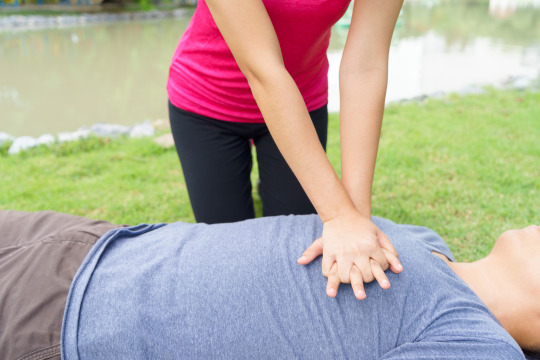
You've got learned you need a CPR certification. However , you aren't sure which one you need. And you don't know if a certification from the American Cardiovascular system Association, American Red Cross or another organization is the right choice. If you are frustrated, that is understandable -- selecting the most appropriate CPR certification class can be very confusing! Here are the four questions to ask yourself to ensure that you sign up for the right CPR certification class: Which CPR certification do I need: standard or healthcare provider? Do I need an AED certification additionally? Does my CPR certification need to focus on infants and children? Should I choose the American Heart Association or Us Red Cross? Which CPR Certification Do I Need? Most people need a standard CPR certification, often called CPR for the layperson. Professions that usually fall into this category are: Teacher Coach Camp counselor School bus driver Personal trainer Daycare workman Babysitter Nursing home employee Construction worker Healthcare providers are required to take a more advanced CPR class. Professions that usually require a healthcare provider CPR certification are: Nurse Nursing assistant Medical assistant Respiratory therapist Dentist Dental assistant Paramedic EMT Police officer Firefighter Physical therapist Occupational therapist Do I Need An AED Certification As Well? Check to see if you also need to end up certified to use an AED. AED stands for Automated External Defibrillator - a mobile defibrillator designed for the public to make use of. Most CPR classes include material on how to use an AED, but not all of them. Do I Need An Infant And Infant CPR Certification? Some people need their CPR certification to focus on infants and children, such as foster parents or daycare workers. The American Red Cross can be very helpful for addressing this because they break their CPR classes into little one, child and adult components. Should I Choose The American Heart Association Or American Red Cross? There are many organizations that can certify you in CPR, but usually the two preferred organizations are the American Heart Association (AHA) and the Usa Red Cross (ARC). Some employers or regulatory organizations will also accept a certification from the American Safety & Health Institute (ASHI). If you are required to get a CPR certification, ask whomever requires it if they prefer a accreditation from the AHA or ARC. Some accept one, but not the other. If you have searched for a CPR class on the Internet, you might have seen ads for on-line based CPR classes costing $19. 95. Stay away from these! Most employers are not going to take an on-line only course. And they shouldn't. You need to practice the skills used to save a life, rather than only studying about the skills. American Heart Association This is the current list of CPR classes for the American Heart Association: Heartsaver CPR AED - Includes adult, child and infant CPR and AED. Basic Life Support for Healthcare Service providers - The CPR course for healthcare professionals. Because the class has a long name, you will see variations in precisely how it's listed, such as "BLS" or "CPR for Healthcare Providers. " American Red Cross American Red Frustrated breaks their CPR classes into components of infant, child, adult, and AED, which can be helpful and confusing. Like they frequently offer infant and child CPR as a single class. Adult CPR is often taught as its own category. Classes with infant, child and adult CPR taught together are also offered. The ARC healthcare provider course is considered, "CPR For The Professional Rescuer. " Some healthcare employers do not accept this course to satisfy their requirements. Of course, confer with your employer first. Before you sign up for an ARC CPR class be sure you know exactly what components the class is usually covering. Signing Up For A Class The AHA and ARC have upcoming classes listed on their websites. If you can't discover a class at the time and location you want, try a privately owned training company that can certify you with the AHA together with ARC. Another option is to hire a private company to teach an on-site AHA or ARC CPR class. A lot of these classes offer flexibility in scheduling and can often be less expensive for large groups.
0 notes
Photo
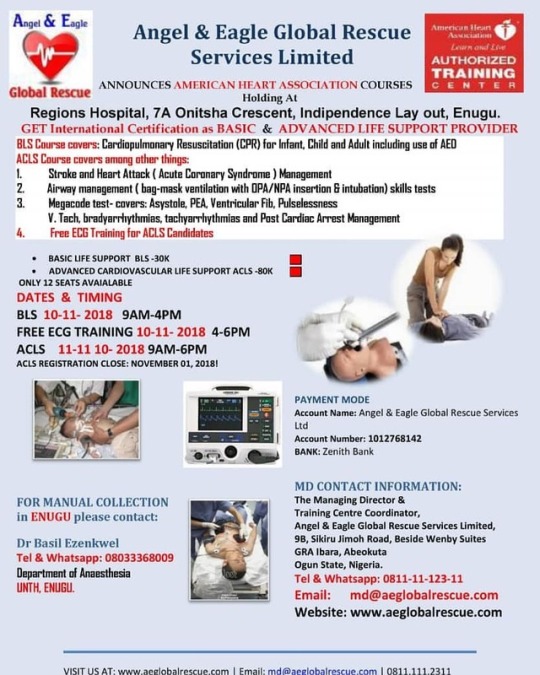
Get your American Heart Association (AHA) Certifications over a WEEKEND Training Venues: Warri Nov 3-4 Enugu Nov 10-11 Port Harcourt Nov 17-18 Lagos Nov 24-25 & Dec 1-2 Jos Dec Dec 1-2 Ilorin Dec 8-10 Abuja Dec 15-16 Manual pickup NOW AVAILABLE in any of the venues above Class Timing BLS Sat 9am-3:300pm then ACLS/PALS Sat 4:00pm-6pm Free ECG Class and ACLS Overview ACLS Sun 9am-6pm Cost BLS 30k --- 5 CPD ACLS 80k --- 10 CPD PALS 90k --- 10 CPD Get both BLS PLUS ACLS/PALS over a WEEKEND! May payment, pick-up your manuals in any of the venues above, join any of our classes and get AHA Certifications. We are international training Center for American Heart Association (AHA Training Center Number ZZ20951), American Safety and Health Institute (ASHI) and American Medic First Aid. ALL our courses has been accredited as Continuous Professional Development (CPD) Points by Medical and Dental Council of Nigeria (MDCN), Medical Rehabilitation Therapy Board (MRTB) of Nigeria and Medical Laboratory Scientists Council of Nigeria for Nigerian Doctors and Physiotherapists and Medical Laboratory Scientist respectively. The Managing Director & Training Center Coordinator Angel &Eagle Global Rescue Services Limited Tel & Whatsapp: 0811-11-123-11 Email: [email protected] Website: www.aeglobalrescue.com https://www.instagram.com/p/BpfY3EeFcjlGfvJIYXWfCI5IcEYEFaHtaY-XfA0/?utm_source=ig_tumblr_share&igshid=1cqml4nsf0pcx
0 notes
Photo

BAMRU doesn't accept ASHI CPR Pro, so I took a class today to get my AHA BLS Provider cert.
Fun fact: chest compressions should be performed at a rate of 100-120 per minute. "Stayin' Alive" by the Bee Gees clocks in at 104 bpm, and "Another One Bites the Dust" by Queen is 110 bpm.
0 notes
Text
Basic Life Support | Apr 28 | Lahore
Basic Life Support (BLS) program is for participants to gain or improve knowledge and skill proficiency in high-quality CPR skills. In our hands-on approach, students participate in scenarios and learning stations to become a Lifesaver! BLS reflects the latest resuscitation science and treatment recommendations published and conforms with the American Heart Association (AHA) Guidelines Update for…

View On WordPress
#Adult BLS#AHA#AHA BLS#AHA BLS and ASHI BLS#AHA BLS certification#American BLS Certification#American heart association#american safety and health institute#ashi#ASHI Basic Life Support#ASHI BLS#ASHI BLS Certification#ASHI BLS Course#ASHI BLS training#ASHI USA BLS#basic life support#Basic Life Support by American Safety and Health Institute#Basic Life Support by ASHI#Basic Life Support Certification#BLS certification#BLS certification course in Karachi#BLS certification in Karachi#BLS certification in Lahore#BLS Course#BLS course in Karachi#BLS course in Lahore#BLS for allied healthcare professionals#BLS for care providers#BLS for doctors#BLS for healthcare professionals
0 notes
Text
Basic Life Support by ASHI USA | Apr 28 | Lahore
Basic Life Support (BLS) program is for participants to gain or improve knowledge and skill proficiency in high-quality CPR skills. In our hands-on approach, students participate in scenarios and learning stations to become a Lifesaver! BLS reflects the latest resuscitation science and treatment recommendations published and conforms with the American Heart Association (AHA) Guidelines Update for…

View On WordPress
#Adult BLS#AHA#AHA BLS#AHA BLS and ASHI BLS#AHA BLS certification#American BLS Certification#American heart association#american safety and health institute#ashi#ASHI Basic Life Support#ASHI BLS#ASHI BLS Certification#ASHI BLS Course#ASHI BLS training#ASHI USA BLS#basic life support#Basic Life Support by American Safety and Health Institute#Basic Life Support by ASHI#Basic Life Support Certification#BLS certification#BLS certification course in Karachi#BLS certification in Karachi#BLS certification in Lahore#BLS Course#BLS course in Karachi#BLS course in Lahore#BLS training#health and safety institute#HSI USA#Karachi
0 notes
Text
Basic Life Support by ASHI USA | Sep 9 | Karachi
Basic Life Support (BLS) program is for participants to gain or improve knowledge and skill proficiency in high-quality CPR skills. In our hands-on approach, students participate in scenarios and learning stations to become a Lifesaver! BLS reflects the latest resuscitation science and treatment recommendations published and conforms with the 2020 American Heart Association (AHA) Guidelines…
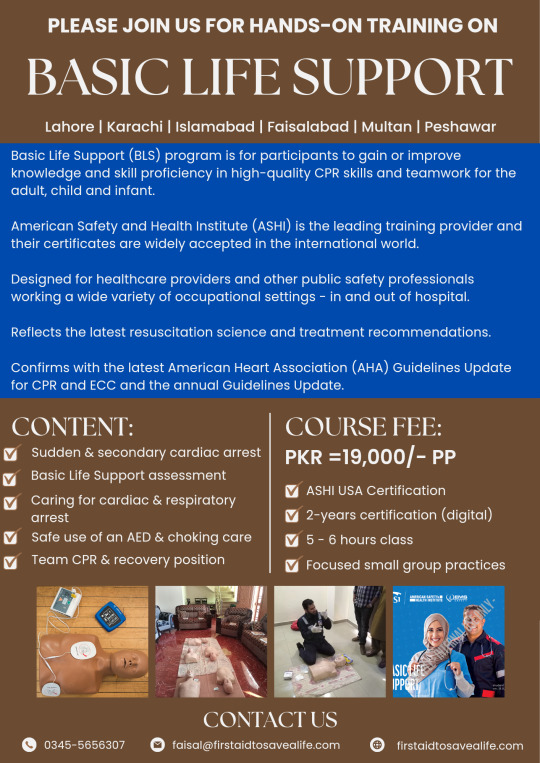
View On WordPress
#Adult BLS#AHA BLS#AHA BLS and ASHI BLS#American BLS#American BLS Certification#american safety and health institute#ashi#ASHI Basic Life Support#ASHI BLS#ASHI BLS Certification#ASHI BLS Course#ASHI BLS training#ASHI USA BLS#basic life support#Basic Life Support by American Safety and Health Institute#Basic Life Support by ASHI#Basic Life Support Certification#BLS certification by USA#BLS certification course in Karachi#BLS certification in Karachi#BLS certification in Lahore#BLS course in Karachi#BLS course in Lahore#health and safety institute#HSI BLS#HSI USA#Karachi#Lahore
0 notes
Text
Basic Life Support by ASHI USA | Aug 19 | Lahore
Basic Life Support (BLS) program is for participants to gain or improve knowledge and skill proficiency in high-quality CPR skills. In our hands-on approach, students participate in scenarios and learning stations to become a Lifesaver! BLS reflects the latest resuscitation science and treatment recommendations published and conforms with the 2020 American Heart Association (AHA) Guidelines…
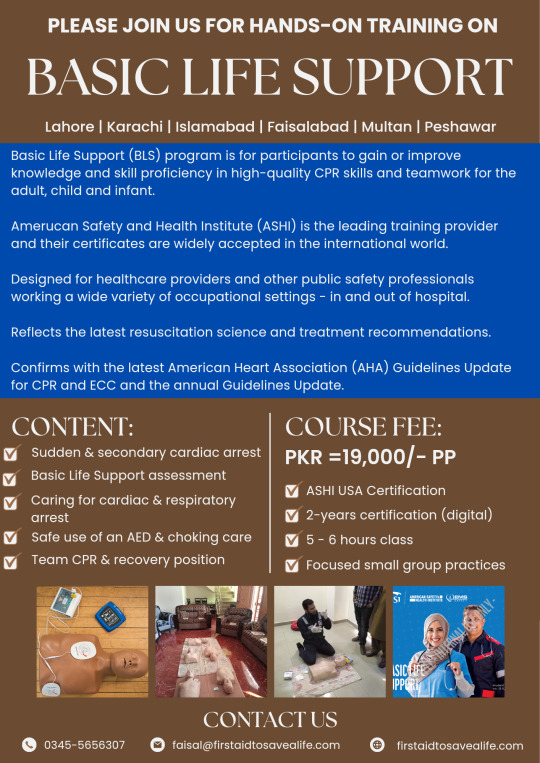
View On WordPress
#Adult BLS#AHA BLS#AHA BLS and ASHI BLS#American BLS Certification#american safety and health institute#ashi#ASHI Basic Life Support#ASHI BLS#ASHI BLS Certification#ASHI BLS Course#ASHI BLS training#ASHI USA BLS#basic life support#Basic Life Support by American Safety and Health Institute#Basic Life Support by ASHI#Basic Life Support Certification#BLS certification course in Karachi#BLS certification in Karachi#BLS certification in Lahore#BLS course in Karachi#BLS course in Lahore#health and safety institute#HSI USA#Karachi#Lahore
0 notes
Text
Basic Life Support by ASHI USA | June 2 | Karachi
Basic Life Support (BLS) program is for participants to gain or improve knowledge and skill proficiency in high-quality CPR skills. In our hands-on approach, students participate in scenarios and learning stations to become a Lifesaver! BLS reflects the latest resuscitation science and treatment recommendations published and conforms with the 2020 American Heart Association (AHA) Guidelines…

View On WordPress
#Adult BLS#AHA BLS#AHA BLS and ASHI BLS#ashi#ASHI Basic Life Support#ASHI BLS#ASHI BLS Certification#ASHI BLS Course#ASHI BLS training#ASHI USA BLS#basic life support#Basic Life Support by American Safety and Health Institute#Basic Life Support by ASHI#Basic Life Support Certification#BLS certification course in Karachi#BLS certification in Karachi#BLS course in Karachi
0 notes